Business Environment Analysis Report: British Airways Case Study
VerifiedAdded on 2019/12/03
|13
|4413
|226
Report
AI Summary
This report provides a comprehensive analysis of the business environment of British Airways, examining various internal and external factors that influence its operations. The report begins with an introduction to the business environment and then delves into the purposes of different types of organizations, followed by an exploration of British Airways' vision, mission, and objectives. Key stakeholders, including customers, employees, government, and shareholders, are identified, and the impact of various challenges on them is assessed. The report further examines how British Airways fulfills its responsibilities to these stakeholders. The economic environment, including economic systems, fiscal and monetary policies, and competition policy, is analyzed in terms of its impact on the airline's activities. Market structures and market forces are also discussed, along with the influence of business and cultural environments. Additionally, the report explores the significance of international trade and the impact of global factors and European Union policies on British Airways. The analysis highlights the challenges and opportunities faced by the airline within its complex business landscape.
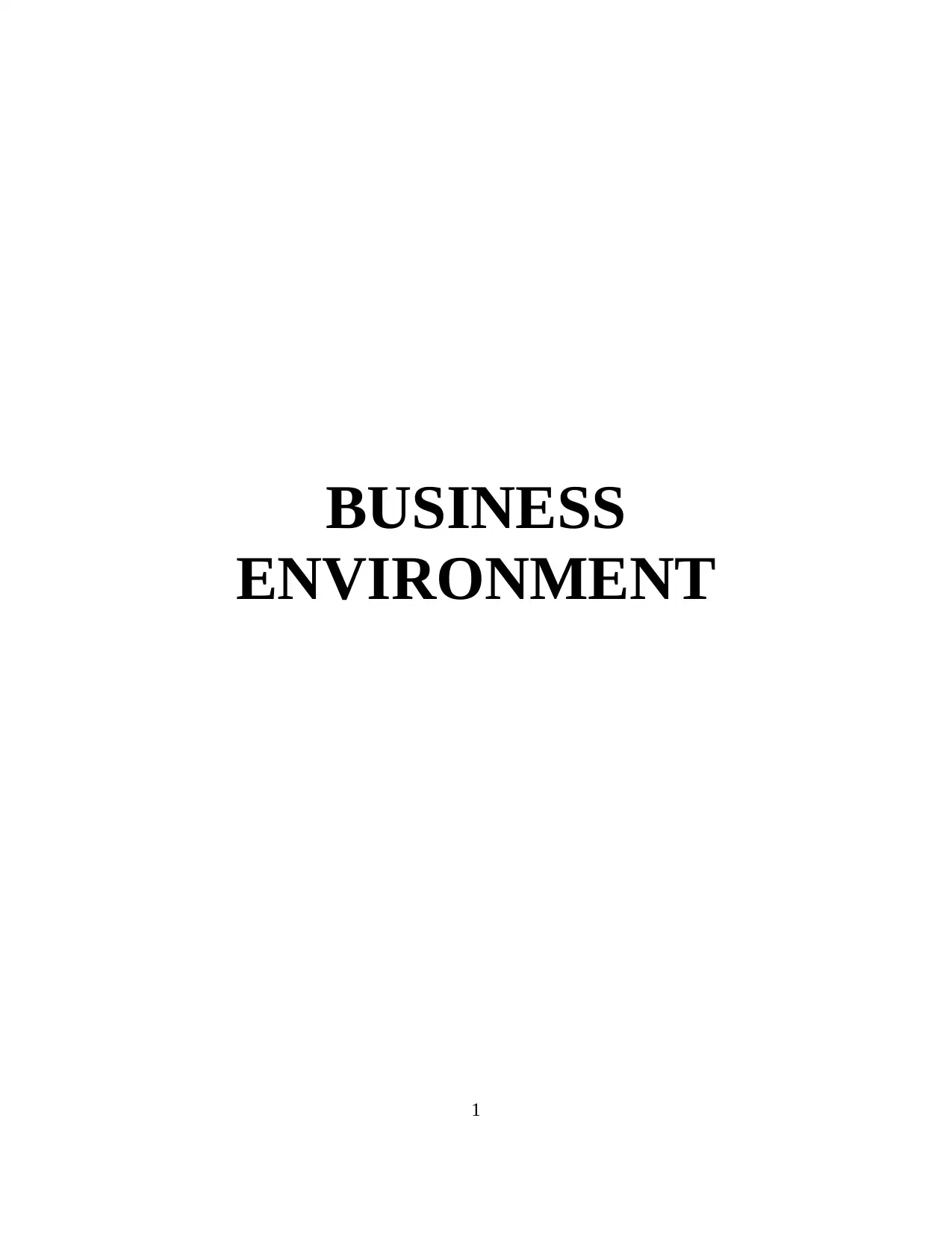
BUSINESS
ENVIRONMENT
1
ENVIRONMENT
1
Paraphrase This Document
Need a fresh take? Get an instant paraphrase of this document with our AI Paraphraser
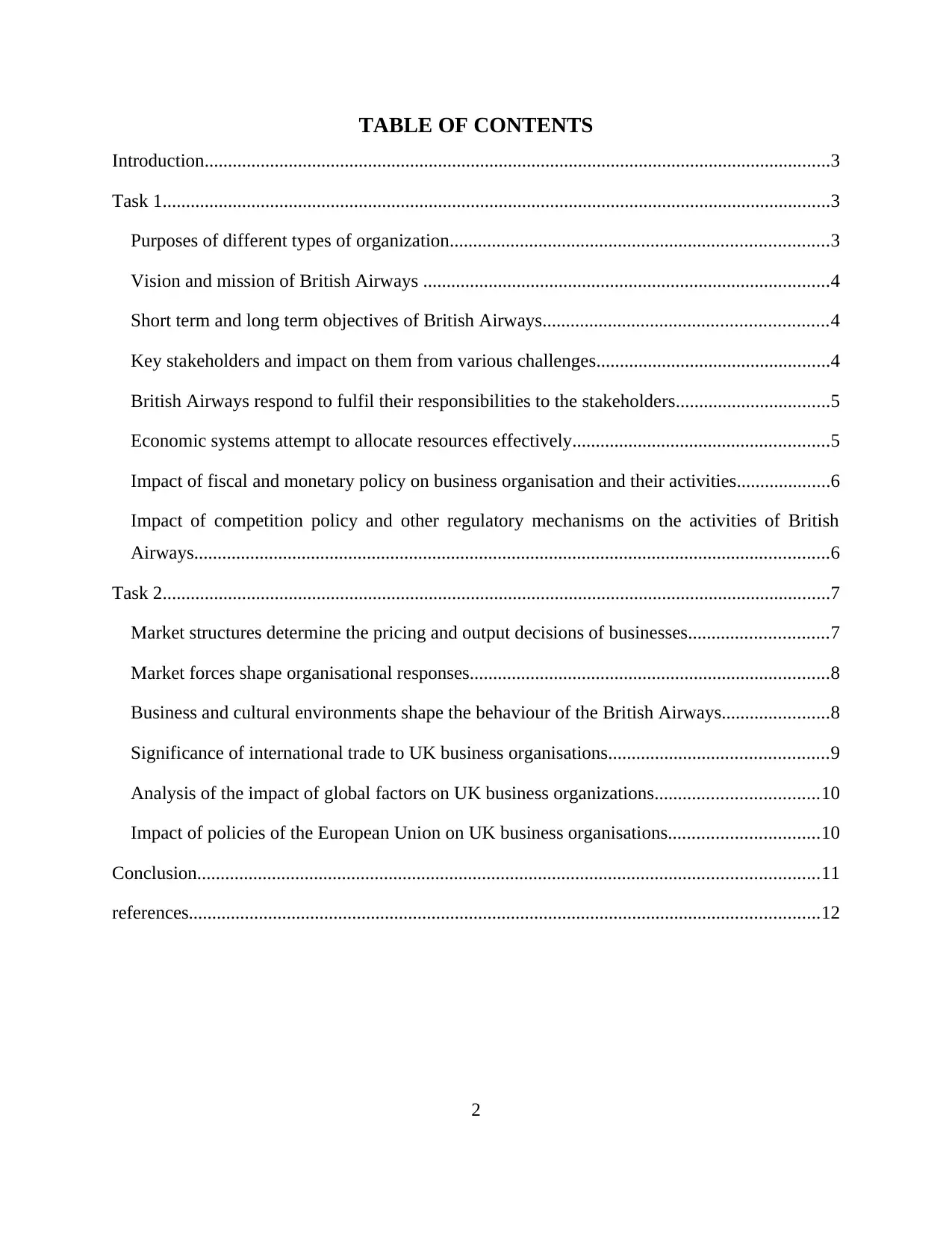
TABLE OF CONTENTS
Introduction......................................................................................................................................3
Task 1...............................................................................................................................................3
Purposes of different types of organization.................................................................................3
Vision and mission of British Airways .......................................................................................4
Short term and long term objectives of British Airways.............................................................4
Key stakeholders and impact on them from various challenges..................................................4
British Airways respond to fulfil their responsibilities to the stakeholders.................................5
Economic systems attempt to allocate resources effectively.......................................................5
Impact of fiscal and monetary policy on business organisation and their activities....................6
Impact of competition policy and other regulatory mechanisms on the activities of British
Airways........................................................................................................................................6
Task 2...............................................................................................................................................7
Market structures determine the pricing and output decisions of businesses..............................7
Market forces shape organisational responses.............................................................................8
Business and cultural environments shape the behaviour of the British Airways.......................8
Significance of international trade to UK business organisations...............................................9
Analysis of the impact of global factors on UK business organizations...................................10
Impact of policies of the European Union on UK business organisations................................10
Conclusion.....................................................................................................................................11
references.......................................................................................................................................12
2
Introduction......................................................................................................................................3
Task 1...............................................................................................................................................3
Purposes of different types of organization.................................................................................3
Vision and mission of British Airways .......................................................................................4
Short term and long term objectives of British Airways.............................................................4
Key stakeholders and impact on them from various challenges..................................................4
British Airways respond to fulfil their responsibilities to the stakeholders.................................5
Economic systems attempt to allocate resources effectively.......................................................5
Impact of fiscal and monetary policy on business organisation and their activities....................6
Impact of competition policy and other regulatory mechanisms on the activities of British
Airways........................................................................................................................................6
Task 2...............................................................................................................................................7
Market structures determine the pricing and output decisions of businesses..............................7
Market forces shape organisational responses.............................................................................8
Business and cultural environments shape the behaviour of the British Airways.......................8
Significance of international trade to UK business organisations...............................................9
Analysis of the impact of global factors on UK business organizations...................................10
Impact of policies of the European Union on UK business organisations................................10
Conclusion.....................................................................................................................................11
references.......................................................................................................................................12
2
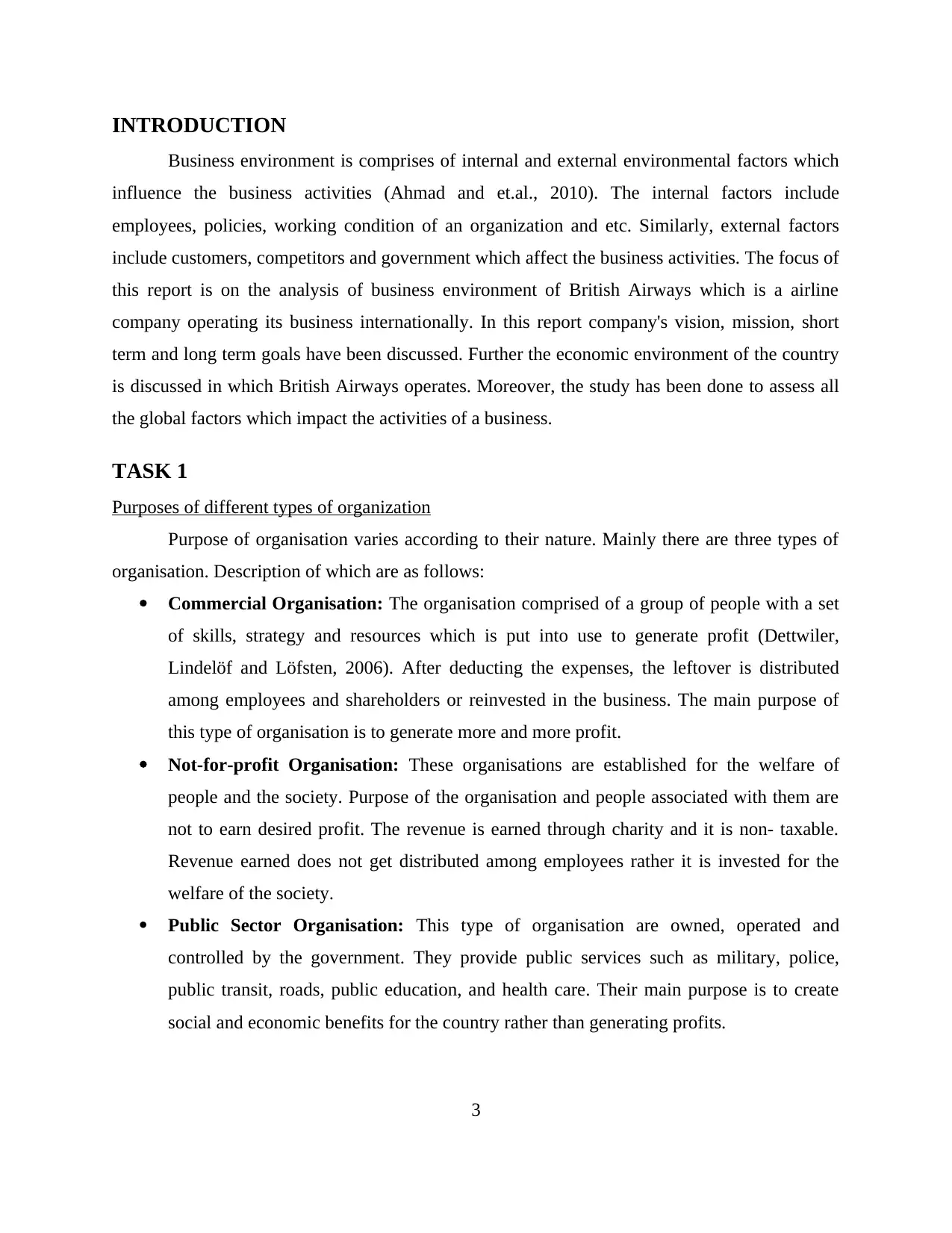
INTRODUCTION
Business environment is comprises of internal and external environmental factors which
influence the business activities (Ahmad and et.al., 2010). The internal factors include
employees, policies, working condition of an organization and etc. Similarly, external factors
include customers, competitors and government which affect the business activities. The focus of
this report is on the analysis of business environment of British Airways which is a airline
company operating its business internationally. In this report company's vision, mission, short
term and long term goals have been discussed. Further the economic environment of the country
is discussed in which British Airways operates. Moreover, the study has been done to assess all
the global factors which impact the activities of a business.
TASK 1
Purposes of different types of organization
Purpose of organisation varies according to their nature. Mainly there are three types of
organisation. Description of which are as follows:
Commercial Organisation: The organisation comprised of a group of people with a set
of skills, strategy and resources which is put into use to generate profit (Dettwiler,
Lindelöf and Löfsten, 2006). After deducting the expenses, the leftover is distributed
among employees and shareholders or reinvested in the business. The main purpose of
this type of organisation is to generate more and more profit.
Not-for-profit Organisation: These organisations are established for the welfare of
people and the society. Purpose of the organisation and people associated with them are
not to earn desired profit. The revenue is earned through charity and it is non- taxable.
Revenue earned does not get distributed among employees rather it is invested for the
welfare of the society.
Public Sector Organisation: This type of organisation are owned, operated and
controlled by the government. They provide public services such as military, police,
public transit, roads, public education, and health care. Their main purpose is to create
social and economic benefits for the country rather than generating profits.
3
Business environment is comprises of internal and external environmental factors which
influence the business activities (Ahmad and et.al., 2010). The internal factors include
employees, policies, working condition of an organization and etc. Similarly, external factors
include customers, competitors and government which affect the business activities. The focus of
this report is on the analysis of business environment of British Airways which is a airline
company operating its business internationally. In this report company's vision, mission, short
term and long term goals have been discussed. Further the economic environment of the country
is discussed in which British Airways operates. Moreover, the study has been done to assess all
the global factors which impact the activities of a business.
TASK 1
Purposes of different types of organization
Purpose of organisation varies according to their nature. Mainly there are three types of
organisation. Description of which are as follows:
Commercial Organisation: The organisation comprised of a group of people with a set
of skills, strategy and resources which is put into use to generate profit (Dettwiler,
Lindelöf and Löfsten, 2006). After deducting the expenses, the leftover is distributed
among employees and shareholders or reinvested in the business. The main purpose of
this type of organisation is to generate more and more profit.
Not-for-profit Organisation: These organisations are established for the welfare of
people and the society. Purpose of the organisation and people associated with them are
not to earn desired profit. The revenue is earned through charity and it is non- taxable.
Revenue earned does not get distributed among employees rather it is invested for the
welfare of the society.
Public Sector Organisation: This type of organisation are owned, operated and
controlled by the government. They provide public services such as military, police,
public transit, roads, public education, and health care. Their main purpose is to create
social and economic benefits for the country rather than generating profits.
3
⊘ This is a preview!⊘
Do you want full access?
Subscribe today to unlock all pages.

Trusted by 1+ million students worldwide
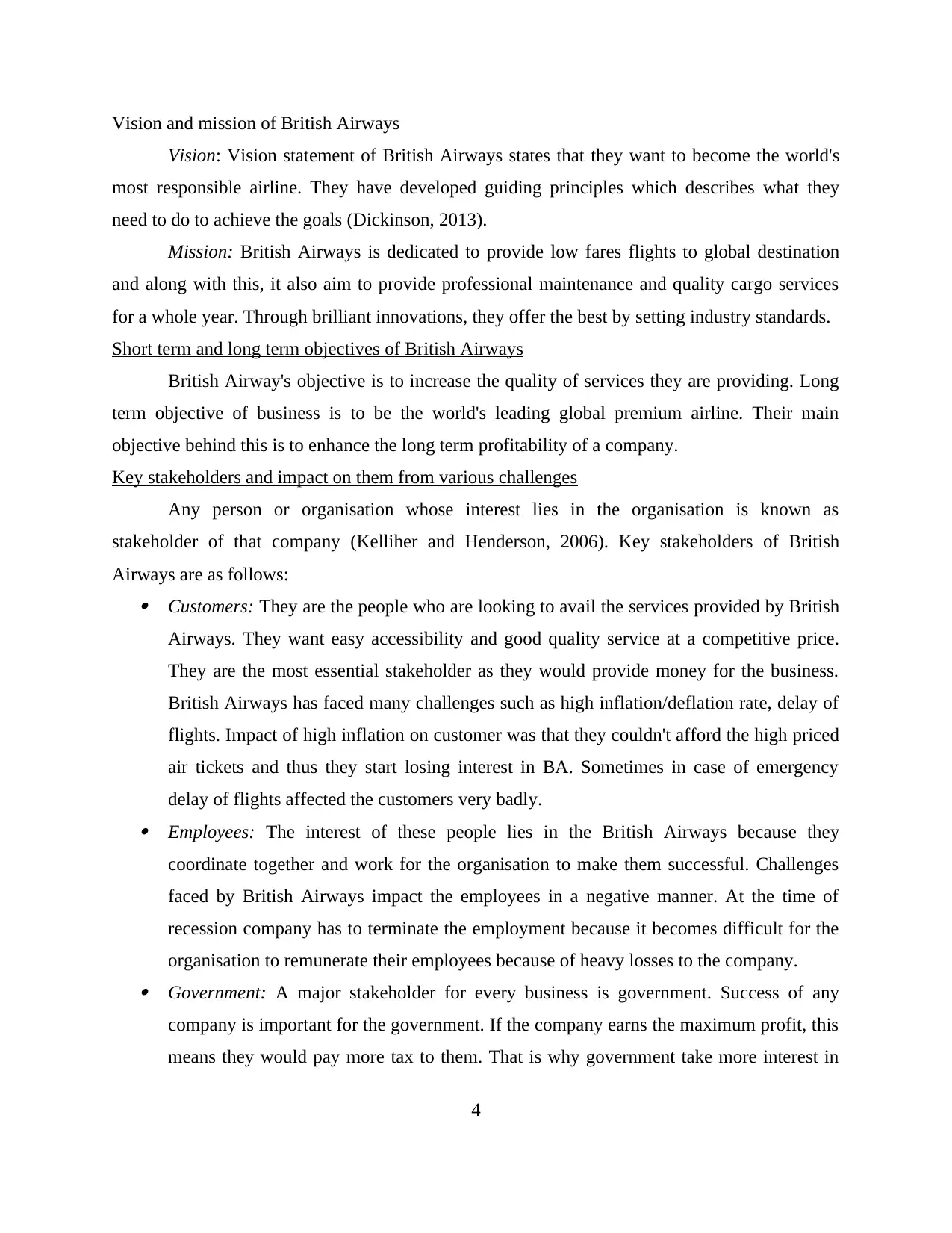
Vision and mission of British Airways
Vision: Vision statement of British Airways states that they want to become the world's
most responsible airline. They have developed guiding principles which describes what they
need to do to achieve the goals (Dickinson, 2013).
Mission: British Airways is dedicated to provide low fares flights to global destination
and along with this, it also aim to provide professional maintenance and quality cargo services
for a whole year. Through brilliant innovations, they offer the best by setting industry standards.
Short term and long term objectives of British Airways
British Airway's objective is to increase the quality of services they are providing. Long
term objective of business is to be the world's leading global premium airline. Their main
objective behind this is to enhance the long term profitability of a company.
Key stakeholders and impact on them from various challenges
Any person or organisation whose interest lies in the organisation is known as
stakeholder of that company (Kelliher and Henderson, 2006). Key stakeholders of British
Airways are as follows: Customers: They are the people who are looking to avail the services provided by British
Airways. They want easy accessibility and good quality service at a competitive price.
They are the most essential stakeholder as they would provide money for the business.
British Airways has faced many challenges such as high inflation/deflation rate, delay of
flights. Impact of high inflation on customer was that they couldn't afford the high priced
air tickets and thus they start losing interest in BA. Sometimes in case of emergency
delay of flights affected the customers very badly. Employees: The interest of these people lies in the British Airways because they
coordinate together and work for the organisation to make them successful. Challenges
faced by British Airways impact the employees in a negative manner. At the time of
recession company has to terminate the employment because it becomes difficult for the
organisation to remunerate their employees because of heavy losses to the company. Government: A major stakeholder for every business is government. Success of any
company is important for the government. If the company earns the maximum profit, this
means they would pay more tax to them. That is why government take more interest in
4
Vision: Vision statement of British Airways states that they want to become the world's
most responsible airline. They have developed guiding principles which describes what they
need to do to achieve the goals (Dickinson, 2013).
Mission: British Airways is dedicated to provide low fares flights to global destination
and along with this, it also aim to provide professional maintenance and quality cargo services
for a whole year. Through brilliant innovations, they offer the best by setting industry standards.
Short term and long term objectives of British Airways
British Airway's objective is to increase the quality of services they are providing. Long
term objective of business is to be the world's leading global premium airline. Their main
objective behind this is to enhance the long term profitability of a company.
Key stakeholders and impact on them from various challenges
Any person or organisation whose interest lies in the organisation is known as
stakeholder of that company (Kelliher and Henderson, 2006). Key stakeholders of British
Airways are as follows: Customers: They are the people who are looking to avail the services provided by British
Airways. They want easy accessibility and good quality service at a competitive price.
They are the most essential stakeholder as they would provide money for the business.
British Airways has faced many challenges such as high inflation/deflation rate, delay of
flights. Impact of high inflation on customer was that they couldn't afford the high priced
air tickets and thus they start losing interest in BA. Sometimes in case of emergency
delay of flights affected the customers very badly. Employees: The interest of these people lies in the British Airways because they
coordinate together and work for the organisation to make them successful. Challenges
faced by British Airways impact the employees in a negative manner. At the time of
recession company has to terminate the employment because it becomes difficult for the
organisation to remunerate their employees because of heavy losses to the company. Government: A major stakeholder for every business is government. Success of any
company is important for the government. If the company earns the maximum profit, this
means they would pay more tax to them. That is why government take more interest in
4
Paraphrase This Document
Need a fresh take? Get an instant paraphrase of this document with our AI Paraphraser
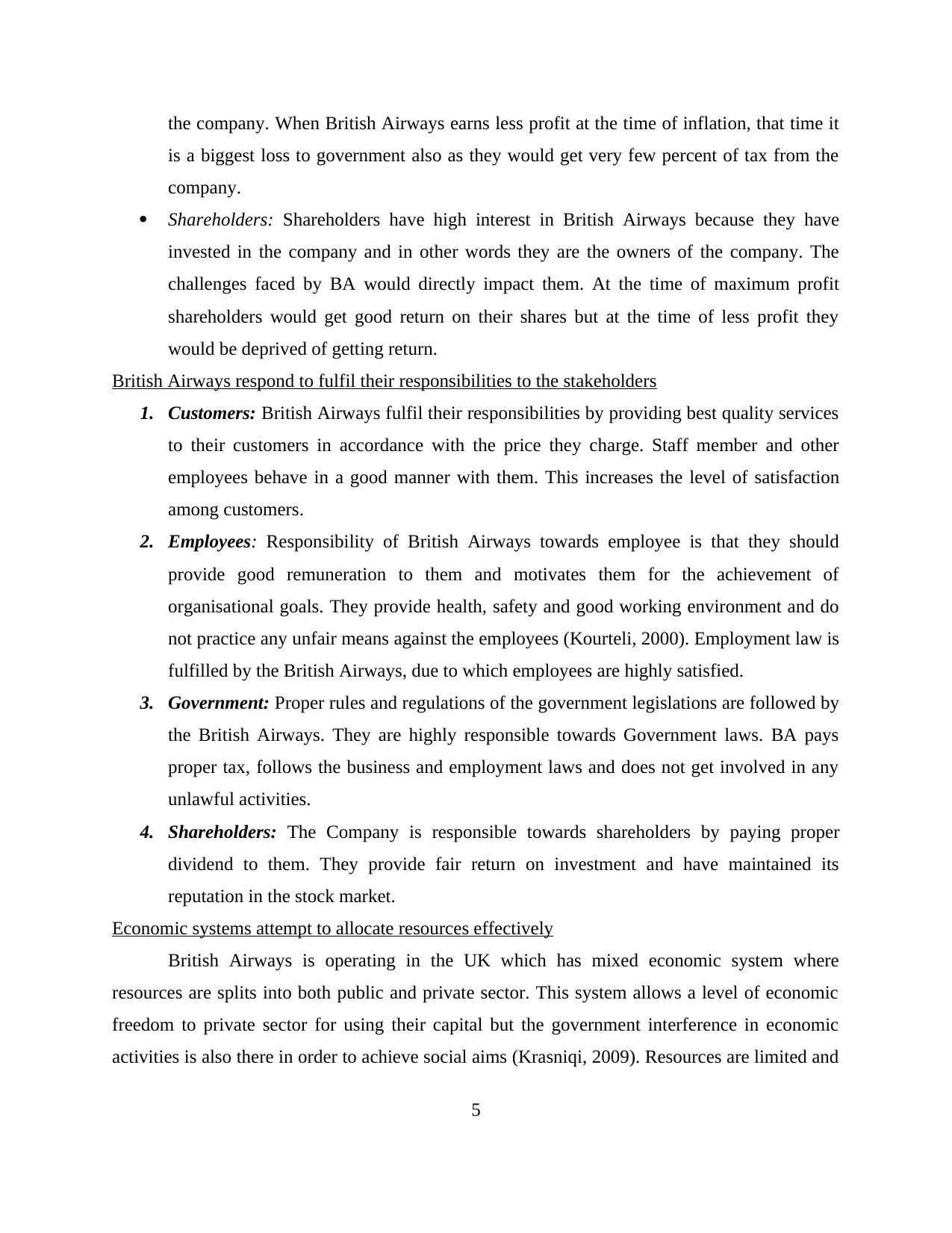
the company. When British Airways earns less profit at the time of inflation, that time it
is a biggest loss to government also as they would get very few percent of tax from the
company.
Shareholders: Shareholders have high interest in British Airways because they have
invested in the company and in other words they are the owners of the company. The
challenges faced by BA would directly impact them. At the time of maximum profit
shareholders would get good return on their shares but at the time of less profit they
would be deprived of getting return.
British Airways respond to fulfil their responsibilities to the stakeholders
1. Customers: British Airways fulfil their responsibilities by providing best quality services
to their customers in accordance with the price they charge. Staff member and other
employees behave in a good manner with them. This increases the level of satisfaction
among customers.
2. Employees: Responsibility of British Airways towards employee is that they should
provide good remuneration to them and motivates them for the achievement of
organisational goals. They provide health, safety and good working environment and do
not practice any unfair means against the employees (Kourteli, 2000). Employment law is
fulfilled by the British Airways, due to which employees are highly satisfied.
3. Government: Proper rules and regulations of the government legislations are followed by
the British Airways. They are highly responsible towards Government laws. BA pays
proper tax, follows the business and employment laws and does not get involved in any
unlawful activities.
4. Shareholders: The Company is responsible towards shareholders by paying proper
dividend to them. They provide fair return on investment and have maintained its
reputation in the stock market.
Economic systems attempt to allocate resources effectively
British Airways is operating in the UK which has mixed economic system where
resources are splits into both public and private sector. This system allows a level of economic
freedom to private sector for using their capital but the government interference in economic
activities is also there in order to achieve social aims (Krasniqi, 2009). Resources are limited and
5
is a biggest loss to government also as they would get very few percent of tax from the
company.
Shareholders: Shareholders have high interest in British Airways because they have
invested in the company and in other words they are the owners of the company. The
challenges faced by BA would directly impact them. At the time of maximum profit
shareholders would get good return on their shares but at the time of less profit they
would be deprived of getting return.
British Airways respond to fulfil their responsibilities to the stakeholders
1. Customers: British Airways fulfil their responsibilities by providing best quality services
to their customers in accordance with the price they charge. Staff member and other
employees behave in a good manner with them. This increases the level of satisfaction
among customers.
2. Employees: Responsibility of British Airways towards employee is that they should
provide good remuneration to them and motivates them for the achievement of
organisational goals. They provide health, safety and good working environment and do
not practice any unfair means against the employees (Kourteli, 2000). Employment law is
fulfilled by the British Airways, due to which employees are highly satisfied.
3. Government: Proper rules and regulations of the government legislations are followed by
the British Airways. They are highly responsible towards Government laws. BA pays
proper tax, follows the business and employment laws and does not get involved in any
unlawful activities.
4. Shareholders: The Company is responsible towards shareholders by paying proper
dividend to them. They provide fair return on investment and have maintained its
reputation in the stock market.
Economic systems attempt to allocate resources effectively
British Airways is operating in the UK which has mixed economic system where
resources are splits into both public and private sector. This system allows a level of economic
freedom to private sector for using their capital but the government interference in economic
activities is also there in order to achieve social aims (Krasniqi, 2009). Resources are limited and
5
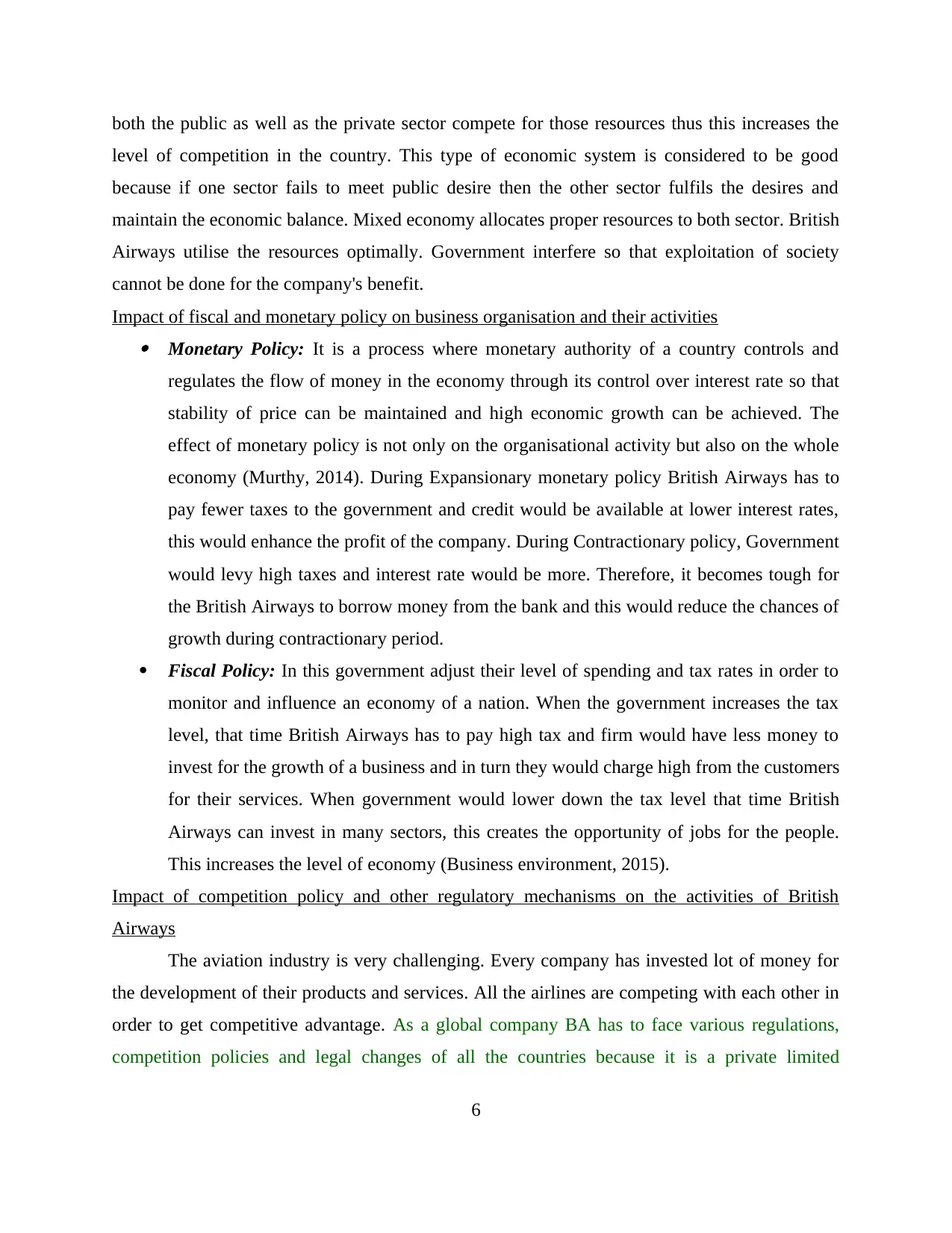
both the public as well as the private sector compete for those resources thus this increases the
level of competition in the country. This type of economic system is considered to be good
because if one sector fails to meet public desire then the other sector fulfils the desires and
maintain the economic balance. Mixed economy allocates proper resources to both sector. British
Airways utilise the resources optimally. Government interfere so that exploitation of society
cannot be done for the company's benefit.
Impact of fiscal and monetary policy on business organisation and their activities Monetary Policy: It is a process where monetary authority of a country controls and
regulates the flow of money in the economy through its control over interest rate so that
stability of price can be maintained and high economic growth can be achieved. The
effect of monetary policy is not only on the organisational activity but also on the whole
economy (Murthy, 2014). During Expansionary monetary policy British Airways has to
pay fewer taxes to the government and credit would be available at lower interest rates,
this would enhance the profit of the company. During Contractionary policy, Government
would levy high taxes and interest rate would be more. Therefore, it becomes tough for
the British Airways to borrow money from the bank and this would reduce the chances of
growth during contractionary period.
Fiscal Policy: In this government adjust their level of spending and tax rates in order to
monitor and influence an economy of a nation. When the government increases the tax
level, that time British Airways has to pay high tax and firm would have less money to
invest for the growth of a business and in turn they would charge high from the customers
for their services. When government would lower down the tax level that time British
Airways can invest in many sectors, this creates the opportunity of jobs for the people.
This increases the level of economy (Business environment, 2015).
Impact of competition policy and other regulatory mechanisms on the activities of British
Airways
The aviation industry is very challenging. Every company has invested lot of money for
the development of their products and services. All the airlines are competing with each other in
order to get competitive advantage. As a global company BA has to face various regulations,
competition policies and legal changes of all the countries because it is a private limited
6
level of competition in the country. This type of economic system is considered to be good
because if one sector fails to meet public desire then the other sector fulfils the desires and
maintain the economic balance. Mixed economy allocates proper resources to both sector. British
Airways utilise the resources optimally. Government interfere so that exploitation of society
cannot be done for the company's benefit.
Impact of fiscal and monetary policy on business organisation and their activities Monetary Policy: It is a process where monetary authority of a country controls and
regulates the flow of money in the economy through its control over interest rate so that
stability of price can be maintained and high economic growth can be achieved. The
effect of monetary policy is not only on the organisational activity but also on the whole
economy (Murthy, 2014). During Expansionary monetary policy British Airways has to
pay fewer taxes to the government and credit would be available at lower interest rates,
this would enhance the profit of the company. During Contractionary policy, Government
would levy high taxes and interest rate would be more. Therefore, it becomes tough for
the British Airways to borrow money from the bank and this would reduce the chances of
growth during contractionary period.
Fiscal Policy: In this government adjust their level of spending and tax rates in order to
monitor and influence an economy of a nation. When the government increases the tax
level, that time British Airways has to pay high tax and firm would have less money to
invest for the growth of a business and in turn they would charge high from the customers
for their services. When government would lower down the tax level that time British
Airways can invest in many sectors, this creates the opportunity of jobs for the people.
This increases the level of economy (Business environment, 2015).
Impact of competition policy and other regulatory mechanisms on the activities of British
Airways
The aviation industry is very challenging. Every company has invested lot of money for
the development of their products and services. All the airlines are competing with each other in
order to get competitive advantage. As a global company BA has to face various regulations,
competition policies and legal changes of all the countries because it is a private limited
6
⊘ This is a preview!⊘
Do you want full access?
Subscribe today to unlock all pages.

Trusted by 1+ million students worldwide
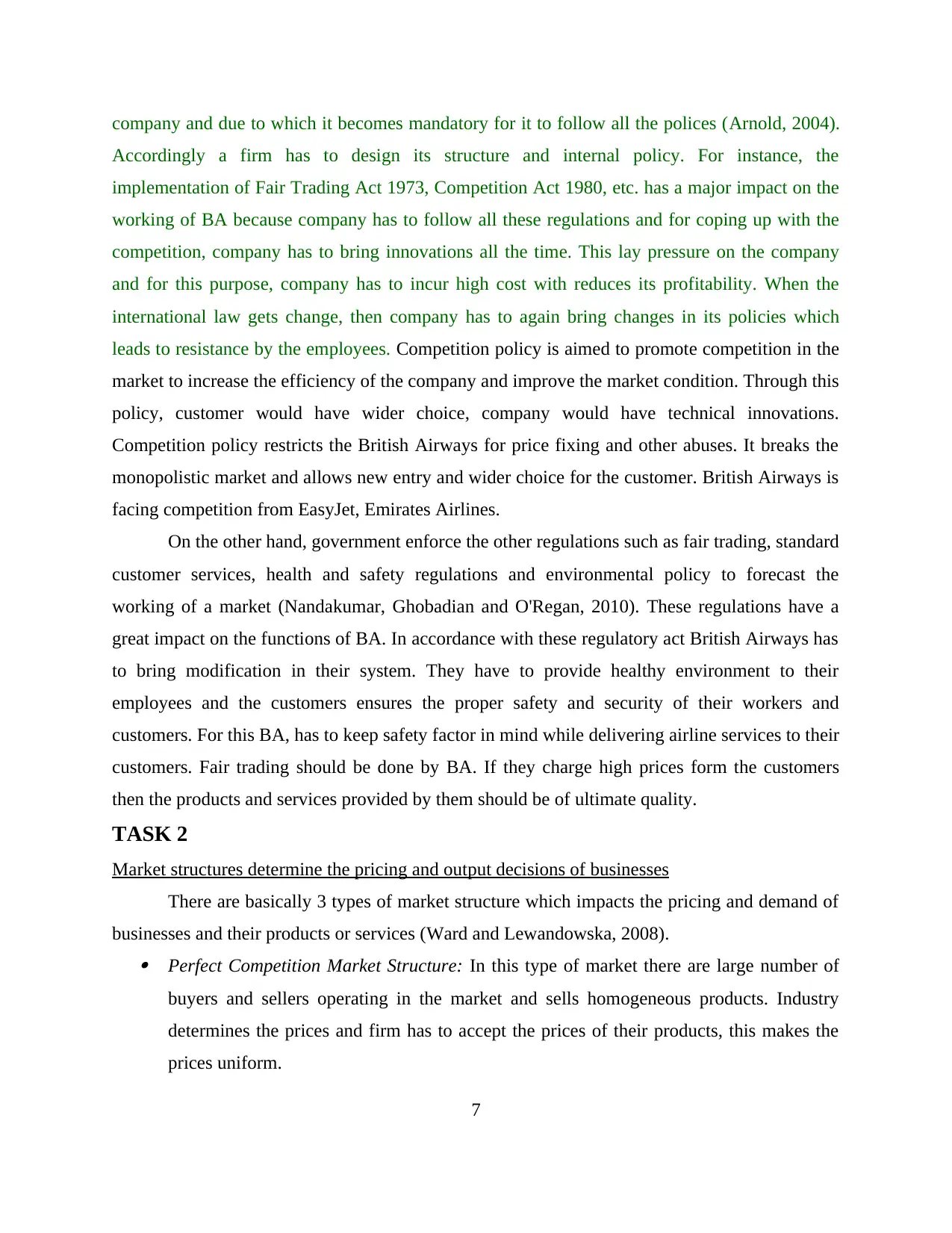
company and due to which it becomes mandatory for it to follow all the polices (Arnold, 2004).
Accordingly a firm has to design its structure and internal policy. For instance, the
implementation of Fair Trading Act 1973, Competition Act 1980, etc. has a major impact on the
working of BA because company has to follow all these regulations and for coping up with the
competition, company has to bring innovations all the time. This lay pressure on the company
and for this purpose, company has to incur high cost with reduces its profitability. When the
international law gets change, then company has to again bring changes in its policies which
leads to resistance by the employees. Competition policy is aimed to promote competition in the
market to increase the efficiency of the company and improve the market condition. Through this
policy, customer would have wider choice, company would have technical innovations.
Competition policy restricts the British Airways for price fixing and other abuses. It breaks the
monopolistic market and allows new entry and wider choice for the customer. British Airways is
facing competition from EasyJet, Emirates Airlines.
On the other hand, government enforce the other regulations such as fair trading, standard
customer services, health and safety regulations and environmental policy to forecast the
working of a market (Nandakumar, Ghobadian and O'Regan, 2010). These regulations have a
great impact on the functions of BA. In accordance with these regulatory act British Airways has
to bring modification in their system. They have to provide healthy environment to their
employees and the customers ensures the proper safety and security of their workers and
customers. For this BA, has to keep safety factor in mind while delivering airline services to their
customers. Fair trading should be done by BA. If they charge high prices form the customers
then the products and services provided by them should be of ultimate quality.
TASK 2
Market structures determine the pricing and output decisions of businesses
There are basically 3 types of market structure which impacts the pricing and demand of
businesses and their products or services (Ward and Lewandowska, 2008). Perfect Competition Market Structure: In this type of market there are large number of
buyers and sellers operating in the market and sells homogeneous products. Industry
determines the prices and firm has to accept the prices of their products, this makes the
prices uniform.
7
Accordingly a firm has to design its structure and internal policy. For instance, the
implementation of Fair Trading Act 1973, Competition Act 1980, etc. has a major impact on the
working of BA because company has to follow all these regulations and for coping up with the
competition, company has to bring innovations all the time. This lay pressure on the company
and for this purpose, company has to incur high cost with reduces its profitability. When the
international law gets change, then company has to again bring changes in its policies which
leads to resistance by the employees. Competition policy is aimed to promote competition in the
market to increase the efficiency of the company and improve the market condition. Through this
policy, customer would have wider choice, company would have technical innovations.
Competition policy restricts the British Airways for price fixing and other abuses. It breaks the
monopolistic market and allows new entry and wider choice for the customer. British Airways is
facing competition from EasyJet, Emirates Airlines.
On the other hand, government enforce the other regulations such as fair trading, standard
customer services, health and safety regulations and environmental policy to forecast the
working of a market (Nandakumar, Ghobadian and O'Regan, 2010). These regulations have a
great impact on the functions of BA. In accordance with these regulatory act British Airways has
to bring modification in their system. They have to provide healthy environment to their
employees and the customers ensures the proper safety and security of their workers and
customers. For this BA, has to keep safety factor in mind while delivering airline services to their
customers. Fair trading should be done by BA. If they charge high prices form the customers
then the products and services provided by them should be of ultimate quality.
TASK 2
Market structures determine the pricing and output decisions of businesses
There are basically 3 types of market structure which impacts the pricing and demand of
businesses and their products or services (Ward and Lewandowska, 2008). Perfect Competition Market Structure: In this type of market there are large number of
buyers and sellers operating in the market and sells homogeneous products. Industry
determines the prices and firm has to accept the prices of their products, this makes the
prices uniform.
7
Paraphrase This Document
Need a fresh take? Get an instant paraphrase of this document with our AI Paraphraser
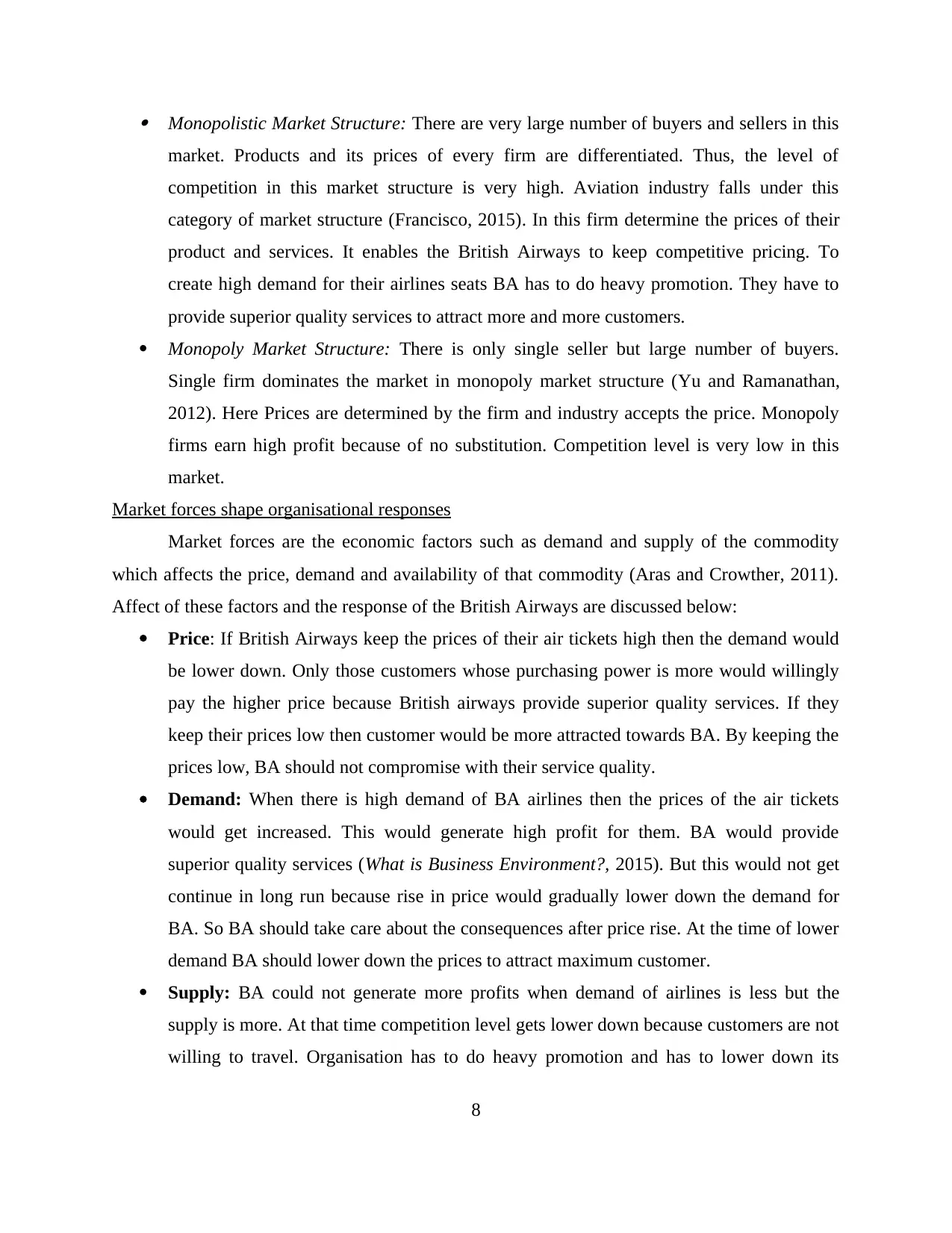
Monopolistic Market Structure: There are very large number of buyers and sellers in this
market. Products and its prices of every firm are differentiated. Thus, the level of
competition in this market structure is very high. Aviation industry falls under this
category of market structure (Francisco, 2015). In this firm determine the prices of their
product and services. It enables the British Airways to keep competitive pricing. To
create high demand for their airlines seats BA has to do heavy promotion. They have to
provide superior quality services to attract more and more customers.
Monopoly Market Structure: There is only single seller but large number of buyers.
Single firm dominates the market in monopoly market structure (Yu and Ramanathan,
2012). Here Prices are determined by the firm and industry accepts the price. Monopoly
firms earn high profit because of no substitution. Competition level is very low in this
market.
Market forces shape organisational responses
Market forces are the economic factors such as demand and supply of the commodity
which affects the price, demand and availability of that commodity (Aras and Crowther, 2011).
Affect of these factors and the response of the British Airways are discussed below:
Price: If British Airways keep the prices of their air tickets high then the demand would
be lower down. Only those customers whose purchasing power is more would willingly
pay the higher price because British airways provide superior quality services. If they
keep their prices low then customer would be more attracted towards BA. By keeping the
prices low, BA should not compromise with their service quality.
Demand: When there is high demand of BA airlines then the prices of the air tickets
would get increased. This would generate high profit for them. BA would provide
superior quality services (What is Business Environment?, 2015). But this would not get
continue in long run because rise in price would gradually lower down the demand for
BA. So BA should take care about the consequences after price rise. At the time of lower
demand BA should lower down the prices to attract maximum customer.
Supply: BA could not generate more profits when demand of airlines is less but the
supply is more. At that time competition level gets lower down because customers are not
willing to travel. Organisation has to do heavy promotion and has to lower down its
8
market. Products and its prices of every firm are differentiated. Thus, the level of
competition in this market structure is very high. Aviation industry falls under this
category of market structure (Francisco, 2015). In this firm determine the prices of their
product and services. It enables the British Airways to keep competitive pricing. To
create high demand for their airlines seats BA has to do heavy promotion. They have to
provide superior quality services to attract more and more customers.
Monopoly Market Structure: There is only single seller but large number of buyers.
Single firm dominates the market in monopoly market structure (Yu and Ramanathan,
2012). Here Prices are determined by the firm and industry accepts the price. Monopoly
firms earn high profit because of no substitution. Competition level is very low in this
market.
Market forces shape organisational responses
Market forces are the economic factors such as demand and supply of the commodity
which affects the price, demand and availability of that commodity (Aras and Crowther, 2011).
Affect of these factors and the response of the British Airways are discussed below:
Price: If British Airways keep the prices of their air tickets high then the demand would
be lower down. Only those customers whose purchasing power is more would willingly
pay the higher price because British airways provide superior quality services. If they
keep their prices low then customer would be more attracted towards BA. By keeping the
prices low, BA should not compromise with their service quality.
Demand: When there is high demand of BA airlines then the prices of the air tickets
would get increased. This would generate high profit for them. BA would provide
superior quality services (What is Business Environment?, 2015). But this would not get
continue in long run because rise in price would gradually lower down the demand for
BA. So BA should take care about the consequences after price rise. At the time of lower
demand BA should lower down the prices to attract maximum customer.
Supply: BA could not generate more profits when demand of airlines is less but the
supply is more. At that time competition level gets lower down because customers are not
willing to travel. Organisation has to do heavy promotion and has to lower down its
8
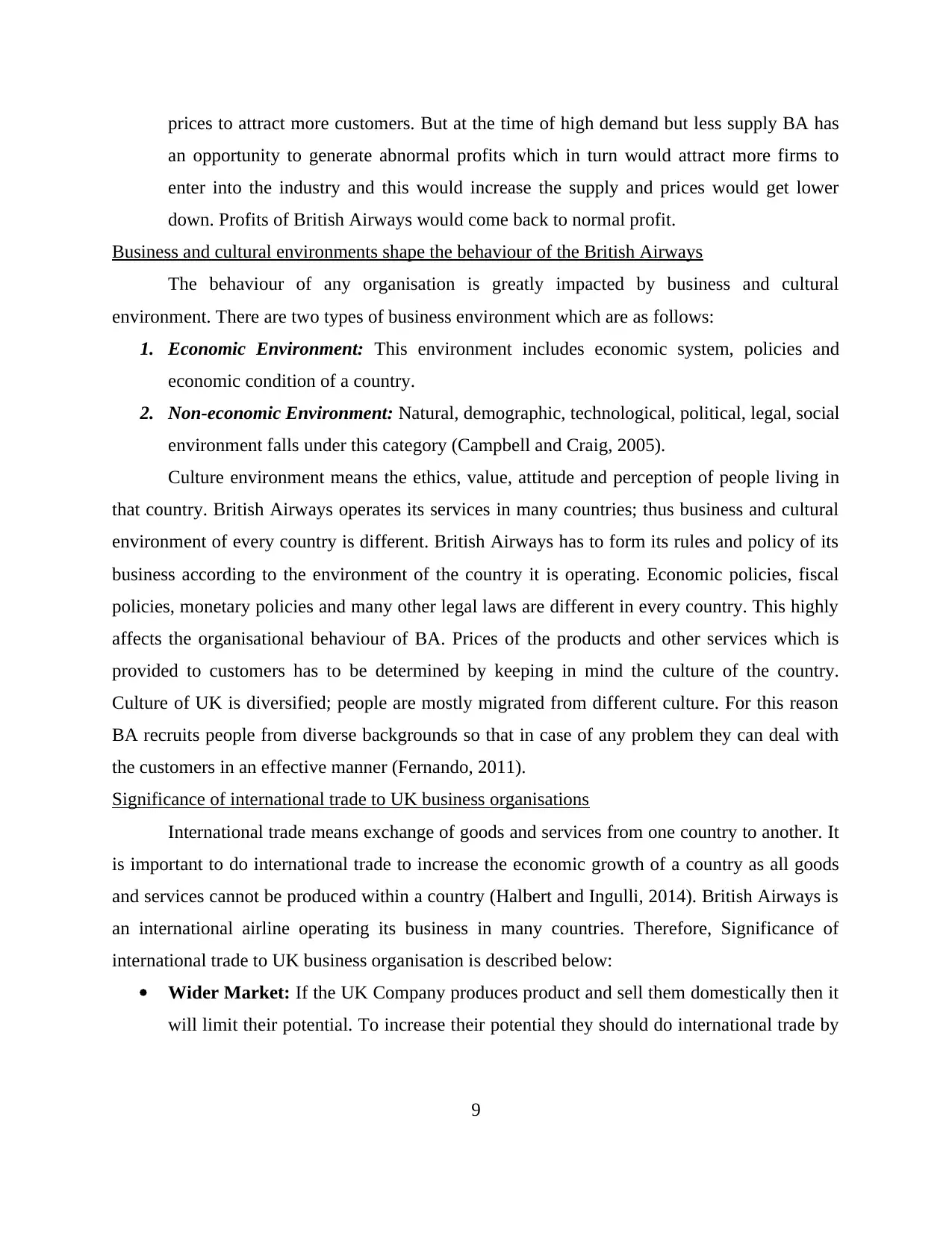
prices to attract more customers. But at the time of high demand but less supply BA has
an opportunity to generate abnormal profits which in turn would attract more firms to
enter into the industry and this would increase the supply and prices would get lower
down. Profits of British Airways would come back to normal profit.
Business and cultural environments shape the behaviour of the British Airways
The behaviour of any organisation is greatly impacted by business and cultural
environment. There are two types of business environment which are as follows:
1. Economic Environment: This environment includes economic system, policies and
economic condition of a country.
2. Non-economic Environment: Natural, demographic, technological, political, legal, social
environment falls under this category (Campbell and Craig, 2005).
Culture environment means the ethics, value, attitude and perception of people living in
that country. British Airways operates its services in many countries; thus business and cultural
environment of every country is different. British Airways has to form its rules and policy of its
business according to the environment of the country it is operating. Economic policies, fiscal
policies, monetary policies and many other legal laws are different in every country. This highly
affects the organisational behaviour of BA. Prices of the products and other services which is
provided to customers has to be determined by keeping in mind the culture of the country.
Culture of UK is diversified; people are mostly migrated from different culture. For this reason
BA recruits people from diverse backgrounds so that in case of any problem they can deal with
the customers in an effective manner (Fernando, 2011).
Significance of international trade to UK business organisations
International trade means exchange of goods and services from one country to another. It
is important to do international trade to increase the economic growth of a country as all goods
and services cannot be produced within a country (Halbert and Ingulli, 2014). British Airways is
an international airline operating its business in many countries. Therefore, Significance of
international trade to UK business organisation is described below:
Wider Market: If the UK Company produces product and sell them domestically then it
will limit their potential. To increase their potential they should do international trade by
9
an opportunity to generate abnormal profits which in turn would attract more firms to
enter into the industry and this would increase the supply and prices would get lower
down. Profits of British Airways would come back to normal profit.
Business and cultural environments shape the behaviour of the British Airways
The behaviour of any organisation is greatly impacted by business and cultural
environment. There are two types of business environment which are as follows:
1. Economic Environment: This environment includes economic system, policies and
economic condition of a country.
2. Non-economic Environment: Natural, demographic, technological, political, legal, social
environment falls under this category (Campbell and Craig, 2005).
Culture environment means the ethics, value, attitude and perception of people living in
that country. British Airways operates its services in many countries; thus business and cultural
environment of every country is different. British Airways has to form its rules and policy of its
business according to the environment of the country it is operating. Economic policies, fiscal
policies, monetary policies and many other legal laws are different in every country. This highly
affects the organisational behaviour of BA. Prices of the products and other services which is
provided to customers has to be determined by keeping in mind the culture of the country.
Culture of UK is diversified; people are mostly migrated from different culture. For this reason
BA recruits people from diverse backgrounds so that in case of any problem they can deal with
the customers in an effective manner (Fernando, 2011).
Significance of international trade to UK business organisations
International trade means exchange of goods and services from one country to another. It
is important to do international trade to increase the economic growth of a country as all goods
and services cannot be produced within a country (Halbert and Ingulli, 2014). British Airways is
an international airline operating its business in many countries. Therefore, Significance of
international trade to UK business organisation is described below:
Wider Market: If the UK Company produces product and sell them domestically then it
will limit their potential. To increase their potential they should do international trade by
9
⊘ This is a preview!⊘
Do you want full access?
Subscribe today to unlock all pages.

Trusted by 1+ million students worldwide
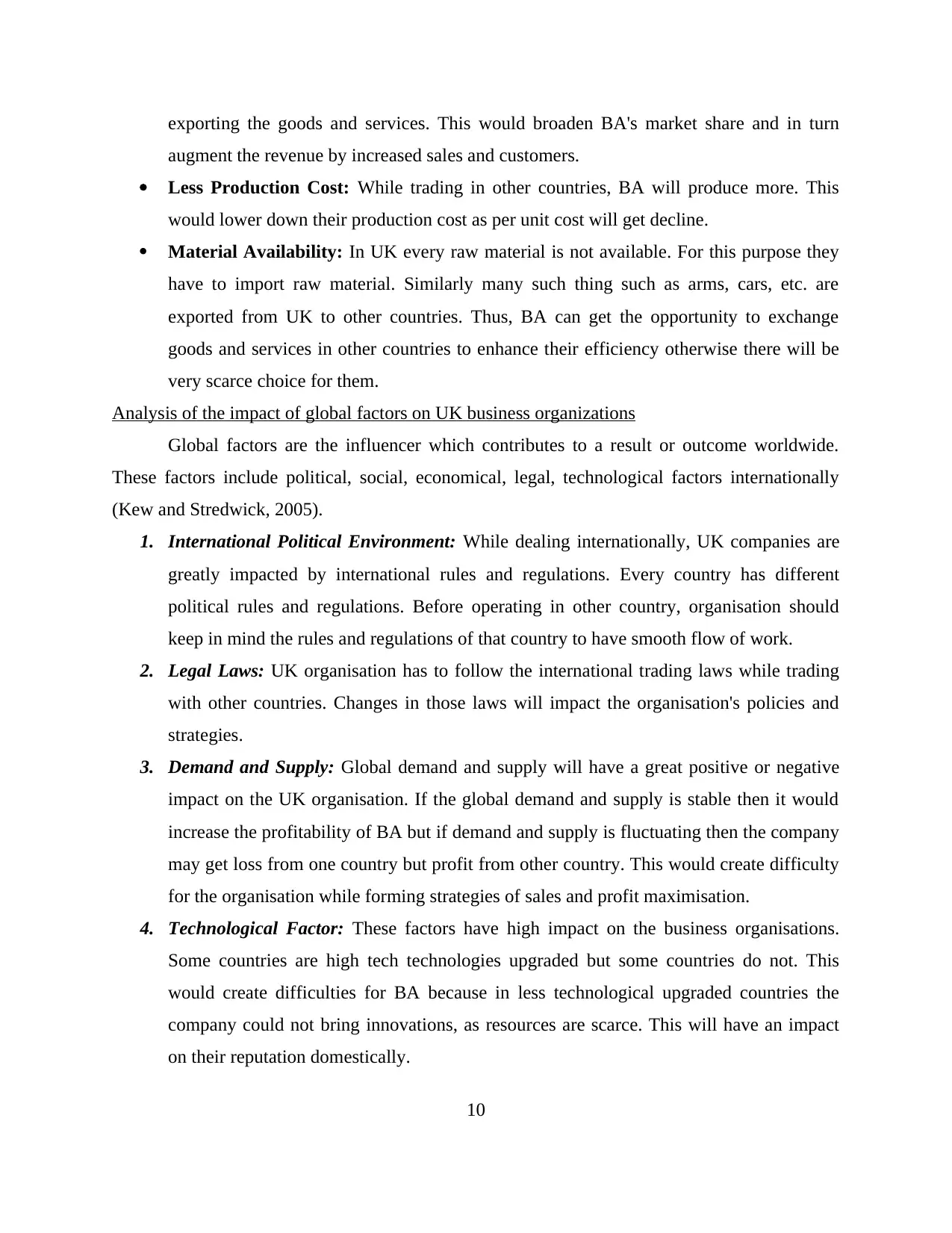
exporting the goods and services. This would broaden BA's market share and in turn
augment the revenue by increased sales and customers.
Less Production Cost: While trading in other countries, BA will produce more. This
would lower down their production cost as per unit cost will get decline.
Material Availability: In UK every raw material is not available. For this purpose they
have to import raw material. Similarly many such thing such as arms, cars, etc. are
exported from UK to other countries. Thus, BA can get the opportunity to exchange
goods and services in other countries to enhance their efficiency otherwise there will be
very scarce choice for them.
Analysis of the impact of global factors on UK business organizations
Global factors are the influencer which contributes to a result or outcome worldwide.
These factors include political, social, economical, legal, technological factors internationally
(Kew and Stredwick, 2005).
1. International Political Environment: While dealing internationally, UK companies are
greatly impacted by international rules and regulations. Every country has different
political rules and regulations. Before operating in other country, organisation should
keep in mind the rules and regulations of that country to have smooth flow of work.
2. Legal Laws: UK organisation has to follow the international trading laws while trading
with other countries. Changes in those laws will impact the organisation's policies and
strategies.
3. Demand and Supply: Global demand and supply will have a great positive or negative
impact on the UK organisation. If the global demand and supply is stable then it would
increase the profitability of BA but if demand and supply is fluctuating then the company
may get loss from one country but profit from other country. This would create difficulty
for the organisation while forming strategies of sales and profit maximisation.
4. Technological Factor: These factors have high impact on the business organisations.
Some countries are high tech technologies upgraded but some countries do not. This
would create difficulties for BA because in less technological upgraded countries the
company could not bring innovations, as resources are scarce. This will have an impact
on their reputation domestically.
10
augment the revenue by increased sales and customers.
Less Production Cost: While trading in other countries, BA will produce more. This
would lower down their production cost as per unit cost will get decline.
Material Availability: In UK every raw material is not available. For this purpose they
have to import raw material. Similarly many such thing such as arms, cars, etc. are
exported from UK to other countries. Thus, BA can get the opportunity to exchange
goods and services in other countries to enhance their efficiency otherwise there will be
very scarce choice for them.
Analysis of the impact of global factors on UK business organizations
Global factors are the influencer which contributes to a result or outcome worldwide.
These factors include political, social, economical, legal, technological factors internationally
(Kew and Stredwick, 2005).
1. International Political Environment: While dealing internationally, UK companies are
greatly impacted by international rules and regulations. Every country has different
political rules and regulations. Before operating in other country, organisation should
keep in mind the rules and regulations of that country to have smooth flow of work.
2. Legal Laws: UK organisation has to follow the international trading laws while trading
with other countries. Changes in those laws will impact the organisation's policies and
strategies.
3. Demand and Supply: Global demand and supply will have a great positive or negative
impact on the UK organisation. If the global demand and supply is stable then it would
increase the profitability of BA but if demand and supply is fluctuating then the company
may get loss from one country but profit from other country. This would create difficulty
for the organisation while forming strategies of sales and profit maximisation.
4. Technological Factor: These factors have high impact on the business organisations.
Some countries are high tech technologies upgraded but some countries do not. This
would create difficulties for BA because in less technological upgraded countries the
company could not bring innovations, as resources are scarce. This will have an impact
on their reputation domestically.
10
Paraphrase This Document
Need a fresh take? Get an instant paraphrase of this document with our AI Paraphraser
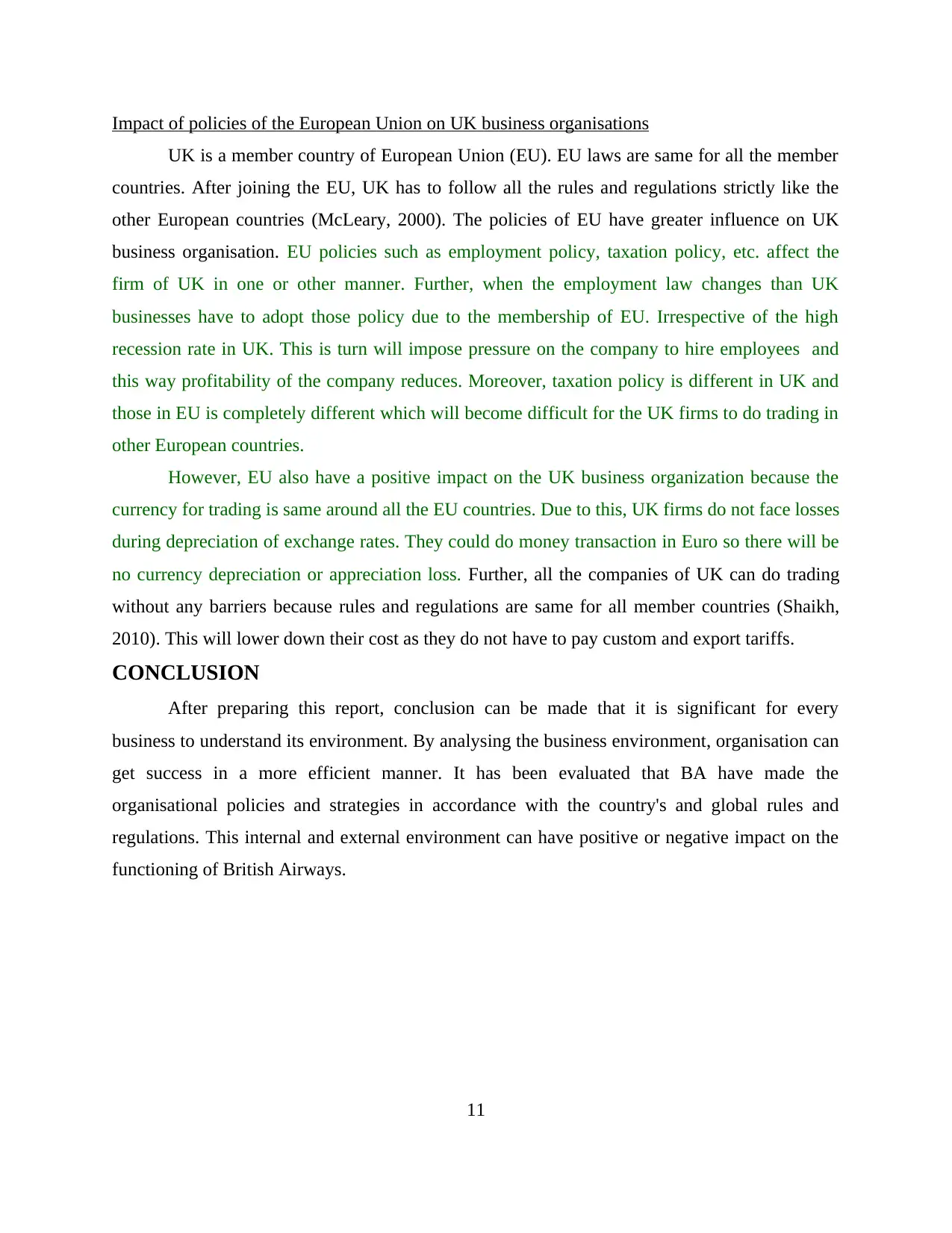
Impact of policies of the European Union on UK business organisations
UK is a member country of European Union (EU). EU laws are same for all the member
countries. After joining the EU, UK has to follow all the rules and regulations strictly like the
other European countries (McLeary, 2000). The policies of EU have greater influence on UK
business organisation. EU policies such as employment policy, taxation policy, etc. affect the
firm of UK in one or other manner. Further, when the employment law changes than UK
businesses have to adopt those policy due to the membership of EU. Irrespective of the high
recession rate in UK. This is turn will impose pressure on the company to hire employees and
this way profitability of the company reduces. Moreover, taxation policy is different in UK and
those in EU is completely different which will become difficult for the UK firms to do trading in
other European countries.
However, EU also have a positive impact on the UK business organization because the
currency for trading is same around all the EU countries. Due to this, UK firms do not face losses
during depreciation of exchange rates. They could do money transaction in Euro so there will be
no currency depreciation or appreciation loss. Further, all the companies of UK can do trading
without any barriers because rules and regulations are same for all member countries (Shaikh,
2010). This will lower down their cost as they do not have to pay custom and export tariffs.
CONCLUSION
After preparing this report, conclusion can be made that it is significant for every
business to understand its environment. By analysing the business environment, organisation can
get success in a more efficient manner. It has been evaluated that BA have made the
organisational policies and strategies in accordance with the country's and global rules and
regulations. This internal and external environment can have positive or negative impact on the
functioning of British Airways.
11
UK is a member country of European Union (EU). EU laws are same for all the member
countries. After joining the EU, UK has to follow all the rules and regulations strictly like the
other European countries (McLeary, 2000). The policies of EU have greater influence on UK
business organisation. EU policies such as employment policy, taxation policy, etc. affect the
firm of UK in one or other manner. Further, when the employment law changes than UK
businesses have to adopt those policy due to the membership of EU. Irrespective of the high
recession rate in UK. This is turn will impose pressure on the company to hire employees and
this way profitability of the company reduces. Moreover, taxation policy is different in UK and
those in EU is completely different which will become difficult for the UK firms to do trading in
other European countries.
However, EU also have a positive impact on the UK business organization because the
currency for trading is same around all the EU countries. Due to this, UK firms do not face losses
during depreciation of exchange rates. They could do money transaction in Euro so there will be
no currency depreciation or appreciation loss. Further, all the companies of UK can do trading
without any barriers because rules and regulations are same for all member countries (Shaikh,
2010). This will lower down their cost as they do not have to pay custom and export tariffs.
CONCLUSION
After preparing this report, conclusion can be made that it is significant for every
business to understand its environment. By analysing the business environment, organisation can
get success in a more efficient manner. It has been evaluated that BA have made the
organisational policies and strategies in accordance with the country's and global rules and
regulations. This internal and external environment can have positive or negative impact on the
functioning of British Airways.
11
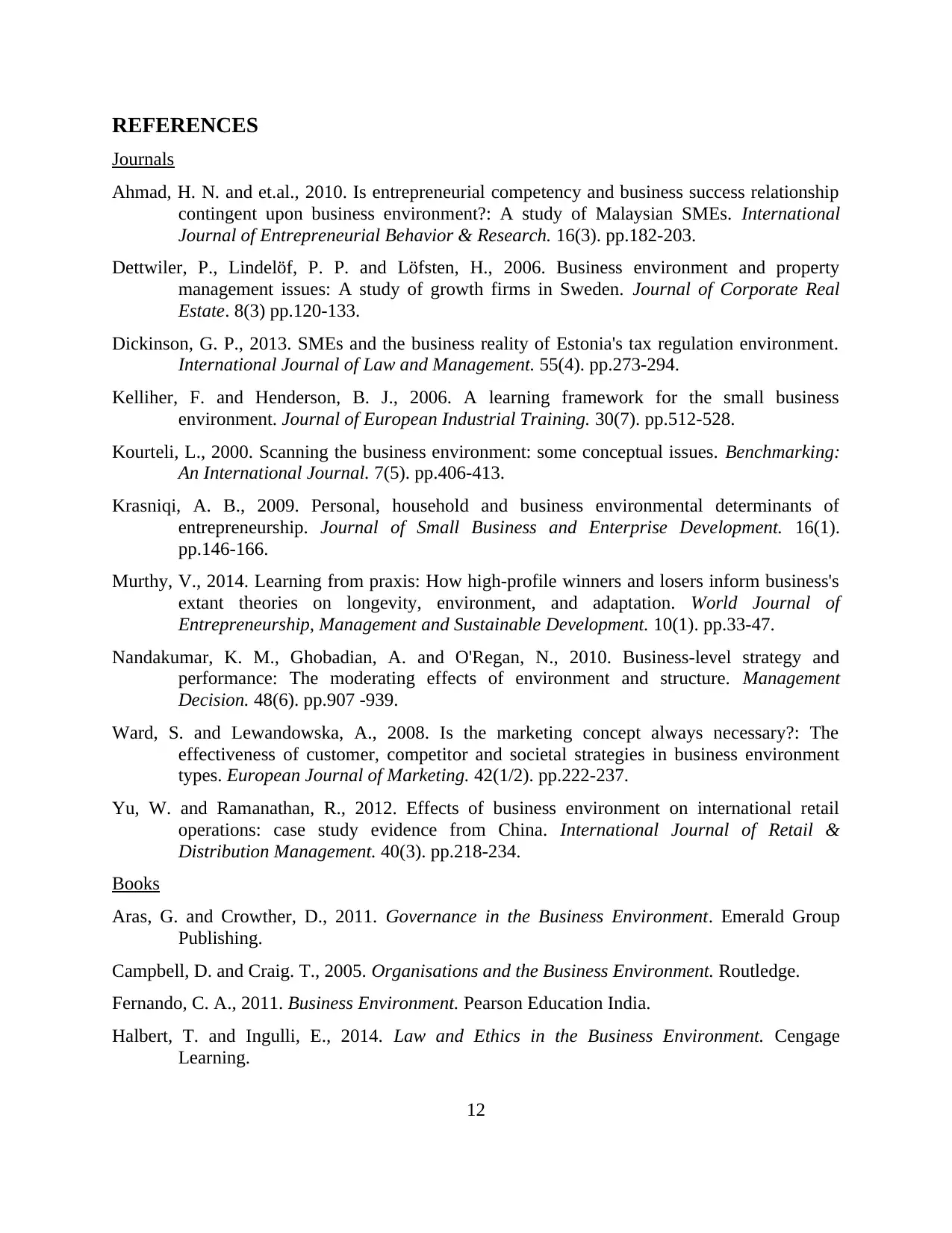
REFERENCES
Journals
Ahmad, H. N. and et.al., 2010. Is entrepreneurial competency and business success relationship
contingent upon business environment?: A study of Malaysian SMEs. International
Journal of Entrepreneurial Behavior & Research. 16(3). pp.182-203.
Dettwiler, P., Lindelöf, P. P. and Löfsten, H., 2006. Business environment and property
management issues: A study of growth firms in Sweden. Journal of Corporate Real
Estate. 8(3) pp.120-133.
Dickinson, G. P., 2013. SMEs and the business reality of Estonia's tax regulation environment.
International Journal of Law and Management. 55(4). pp.273-294.
Kelliher, F. and Henderson, B. J., 2006. A learning framework for the small business
environment. Journal of European Industrial Training. 30(7). pp.512-528.
Kourteli, L., 2000. Scanning the business environment: some conceptual issues. Benchmarking:
An International Journal. 7(5). pp.406-413.
Krasniqi, A. B., 2009. Personal, household and business environmental determinants of
entrepreneurship. Journal of Small Business and Enterprise Development. 16(1).
pp.146-166.
Murthy, V., 2014. Learning from praxis: How high-profile winners and losers inform business's
extant theories on longevity, environment, and adaptation. World Journal of
Entrepreneurship, Management and Sustainable Development. 10(1). pp.33-47.
Nandakumar, K. M., Ghobadian, A. and O'Regan, N., 2010. Business‐level strategy and
performance: The moderating effects of environment and structure. Management
Decision. 48(6). pp.907 -939.
Ward, S. and Lewandowska, A., 2008. Is the marketing concept always necessary?: The
effectiveness of customer, competitor and societal strategies in business environment
types. European Journal of Marketing. 42(1/2). pp.222-237.
Yu, W. and Ramanathan, R., 2012. Effects of business environment on international retail
operations: case study evidence from China. International Journal of Retail &
Distribution Management. 40(3). pp.218-234.
Books
Aras, G. and Crowther, D., 2011. Governance in the Business Environment. Emerald Group
Publishing.
Campbell, D. and Craig. T., 2005. Organisations and the Business Environment. Routledge.
Fernando, C. A., 2011. Business Environment. Pearson Education India.
Halbert, T. and Ingulli, E., 2014. Law and Ethics in the Business Environment. Cengage
Learning.
12
Journals
Ahmad, H. N. and et.al., 2010. Is entrepreneurial competency and business success relationship
contingent upon business environment?: A study of Malaysian SMEs. International
Journal of Entrepreneurial Behavior & Research. 16(3). pp.182-203.
Dettwiler, P., Lindelöf, P. P. and Löfsten, H., 2006. Business environment and property
management issues: A study of growth firms in Sweden. Journal of Corporate Real
Estate. 8(3) pp.120-133.
Dickinson, G. P., 2013. SMEs and the business reality of Estonia's tax regulation environment.
International Journal of Law and Management. 55(4). pp.273-294.
Kelliher, F. and Henderson, B. J., 2006. A learning framework for the small business
environment. Journal of European Industrial Training. 30(7). pp.512-528.
Kourteli, L., 2000. Scanning the business environment: some conceptual issues. Benchmarking:
An International Journal. 7(5). pp.406-413.
Krasniqi, A. B., 2009. Personal, household and business environmental determinants of
entrepreneurship. Journal of Small Business and Enterprise Development. 16(1).
pp.146-166.
Murthy, V., 2014. Learning from praxis: How high-profile winners and losers inform business's
extant theories on longevity, environment, and adaptation. World Journal of
Entrepreneurship, Management and Sustainable Development. 10(1). pp.33-47.
Nandakumar, K. M., Ghobadian, A. and O'Regan, N., 2010. Business‐level strategy and
performance: The moderating effects of environment and structure. Management
Decision. 48(6). pp.907 -939.
Ward, S. and Lewandowska, A., 2008. Is the marketing concept always necessary?: The
effectiveness of customer, competitor and societal strategies in business environment
types. European Journal of Marketing. 42(1/2). pp.222-237.
Yu, W. and Ramanathan, R., 2012. Effects of business environment on international retail
operations: case study evidence from China. International Journal of Retail &
Distribution Management. 40(3). pp.218-234.
Books
Aras, G. and Crowther, D., 2011. Governance in the Business Environment. Emerald Group
Publishing.
Campbell, D. and Craig. T., 2005. Organisations and the Business Environment. Routledge.
Fernando, C. A., 2011. Business Environment. Pearson Education India.
Halbert, T. and Ingulli, E., 2014. Law and Ethics in the Business Environment. Cengage
Learning.
12
⊘ This is a preview!⊘
Do you want full access?
Subscribe today to unlock all pages.

Trusted by 1+ million students worldwide
1 out of 13
Related Documents
Your All-in-One AI-Powered Toolkit for Academic Success.
+13062052269
info@desklib.com
Available 24*7 on WhatsApp / Email
![[object Object]](/_next/static/media/star-bottom.7253800d.svg)
Unlock your academic potential
Copyright © 2020–2025 A2Z Services. All Rights Reserved. Developed and managed by ZUCOL.





